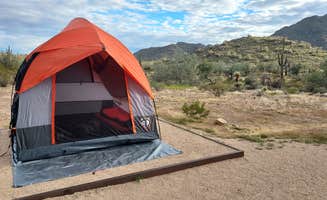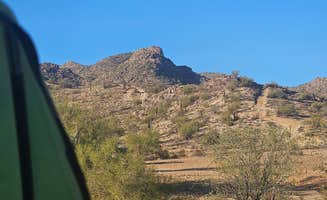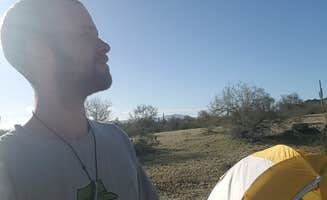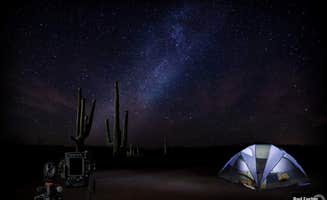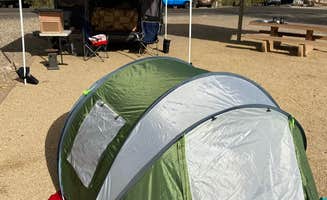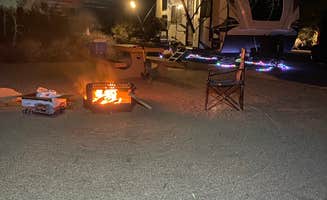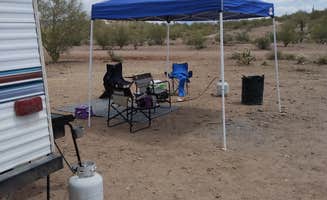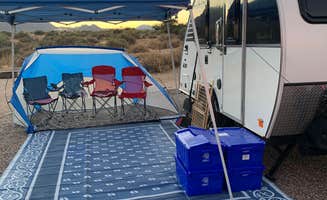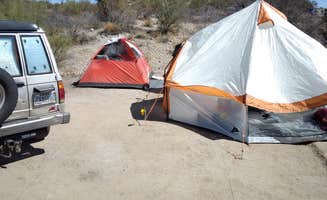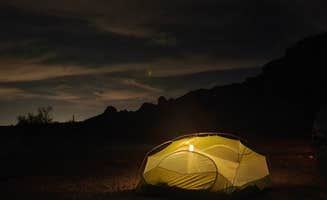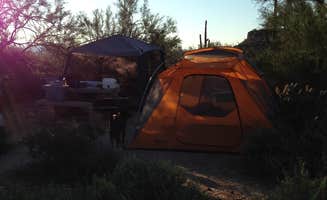Camping spots near Litchfield Park, Arizona range from developed regional parks to primitive desert locations across State Trust lands. The region sits at approximately 1,030 feet elevation in the Sonoran Desert, characterized by saguaro cacti, mesquite trees, and rocky terrain. Most camping areas experience temperature fluctuations of 30°F between day and night, with summer highs regularly exceeding 110°F from June through August.
What to do
Hike diverse desert trails: At White Tank Mountain Regional Park, trails accommodate various skill levels with well-marked routes. "The park has beautiful hiking trails and a great nature center, which offers activities and the regional library. There are a couple of playgrounds in the park as well," notes Ellen W. The Waterfall Trail includes petroglyphs and becomes partially paved for the first half-mile.
Stargaze away from city lights: Desert camping provides exceptional night sky viewing opportunities. "Campsites are behind a rise, so you see stars, not city lights," explains Rusty T. about White Tank Mountain. The park's darker skies make it suitable for astronomy enthusiasts, with county-sponsored astronomy nights occasionally featuring large telescopes and presentations.
Water recreation access: Lake Pleasant Regional Park Campground offers water-based activities including swimming, fishing, and boating. "All kinds of water sports and rentals," mentions Patti S. The lake serves as a cool refuge during warmer months, with boat ramps and rental facilities available seasonally.
What campers like
Spacious desert sites: Campers appreciate the generous spacing at many regional parks. "Sites are far enough from each other so it doesn't feel crowded. Not much vegetation on the campground itself, so sunshine in abundance," shares Ellen W. about White Tank Mountain Regional Park. Sites typically feature gravel or sand surfaces with concrete picnic tables.
Clean facilities: Regional parks maintain well-kept restrooms and common areas. At Skyline Regional Park, "Two-stall, one-sink restroom. No showers. This restroom is also used by the day-use area so by the end of the day, it looks like it has been well-used. It was cleaned at night," reports Lee D. Campground hosts often live on-site year-round at the larger parks.
Wildlife encounters: Many campers enjoy the desert wildlife. "Burros would hang out in our camp grazing grass completely unfazed by the barking dogs and screaming kids," reports Tom W. about Lake Pleasant. Morning and evening hours offer the best wildlife viewing opportunities, with roadrunners, coyotes, and various reptiles commonly spotted.
What you should know
Permit requirements: Dispersed camping on State Trust lands requires permits. At State Land Trust/Inspiration Point, conditions can vary substantially. "State land trust, good spot for a few nights. Gunshots in the distance, but no incidents/casualties... Quite weekdays, loud weekends due to motor vehicles breaking the rules," notes Brent T. The $15-20 annual recreation permit must be obtained before arrival.
Seasonal considerations: Winter and spring provide the most comfortable camping conditions. Temperatures in summer regularly exceed 100°F, making camping difficult without adequate shade or cooling. Fall brings pleasant evening temperatures but can still see daytime highs in the 90s.
Noise factors: Military aircraft and traffic noise affect some camping areas. "From time to time there's a bit of jet noise," mentions Castaway I. about Skyline Regional Park. Luke Air Force Base conducts training flights that pass over several camping areas, particularly in early morning and evening hours.
Tips for camping with families
Look for educational opportunities: Several parks offer interpretive programs. "I've also joined two ranger-led hikes here (Black Rock Loop for sunrise hikes) as well as a county-sponsored astronomy night with access to multiple large telescopes and an astronomy presentation," shares Chenery K. about White Tank Mountain. The nature centers provide exhibits on local flora, fauna, and geology.
Choose sites with amenities: For families with young children, developed campgrounds provide essential facilities. White Tank Mountain Regional Park features "a fire ring, grill, concrete picnic table and water/electric posts," according to Staci R. Family campgrounds typically include flush toilets and running water, making them suitable for campers with young children.
Be aware of natural hazards: Desert camping requires awareness of potential dangers. "The only concern for those traveling with pets... quite a few loose [cholla cactus] even along trails," warns Teresa A. Young children and pets need close supervision to avoid encounters with cacti, scorpions, and occasional rattlesnakes.
Tips from RVers
Consider resort-style parks for amenities: Destiny Phoenix RV Resorts offers more facilities than public lands. "Near I-10. Close together spots but orange, lemon, and grapefruit trees everywhere. They have 2 fenced dog runs. Pretty pool and hot tub. People are very friendly and helpful," according to Missy C. These resorts typically provide full hookups, laundry facilities, and social activities.
Plan for limited hookup options: Not all campgrounds offer full services for RVs. "Wish they had sewer hookup. (There is a dump station)," notes Jamie M. about Lake Pleasant. Most regional parks provide water and electric but may lack sewer connections at individual sites, requiring use of dump stations.
Reserve pull-through sites when available: RVers with larger rigs should book specific site types. According to Dawn F. at Leaf Verde RV Resort, "Regular pull through spots are kind of like buddy spots as your doors face each other. Back in and deluxe sites are decent sized. Roadways are asphalt and large enough to maneuver bigger rigs through."


